Beatified 1864 | Role Saint Name Peter Canisius | |
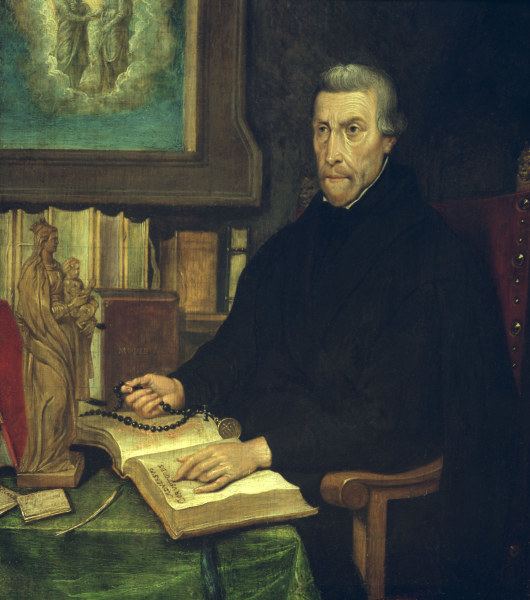 | ||
Books A Small Catechism for Catholics, A Summe of Christian Doctrine, Ane Cathechisme, 1588 | ||
St peter canisius s j
Peter Canisius, S.J. (Dutch: Pieter Kanis, 8 May 1521 – 21 December 1597) was a renowned Dutch Jesuit Catholic priest. He became known for his strong support for the Catholic faith during the Protestant Reformation in Germany, Austria, Bohemia, Moravia, and Switzerland. The restoration of the Catholic Church in Germany after the Protestant Reformation is largely attributed to the work there of the Society of Jesus, which he led. He is venerated in the Catholic Church as a saint and as a Doctor of the Church.
Contents
- St peter canisius s j
- Saint of the Week St Peter Canisius
- Life
- Pastoral strategy
- Mariology of Canisius
- Veneration
- Legacy
- Works
- References
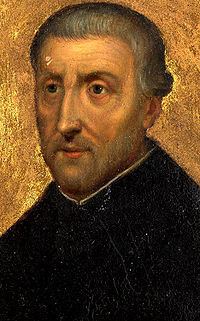
Saint of the Week: St. Peter Canisius
Life
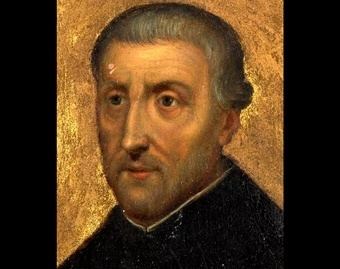
He was born in 1521 in Nijmegen in the Duchy of Guelders, which, until 1549, was part of the Habsburg Netherlands within the Holy Roman Empire and is now the Netherlands. His father was a wealthy burgermeister, Jacob Kanis. His mother, Ægidia van Houweningen, died shortly after Peter's birth. He was sent to study at the University of Cologne, where he earned a Master's degree in 1540, at the age of 19.
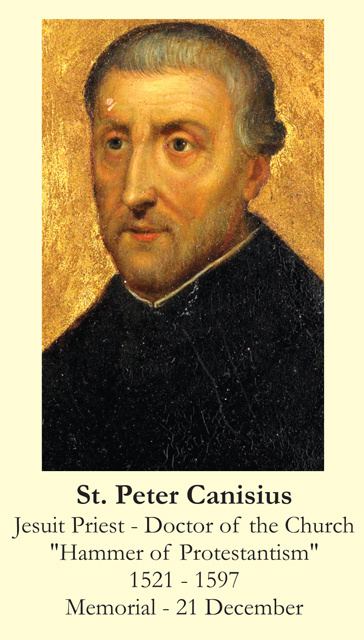
While there, he met Peter Faber, one of the founders of the Society of Jesus. Through him, Canisius became the first Dutchman to join the newly founded Society of Jesus in 1543. Through his preaching and writings, Peter Canisius became one of the most influential Catholics of his time. He supervised the founding and maintenance of the first German-speaking Jesuit colleges, often with little resources at hand. At the same time he preached in the city and vicinity, and debated and taught in the university. Due to his frequent travels between the colleges, a tedious and dangerous occupation at the time, he became known as the Second Apostle of Germany.
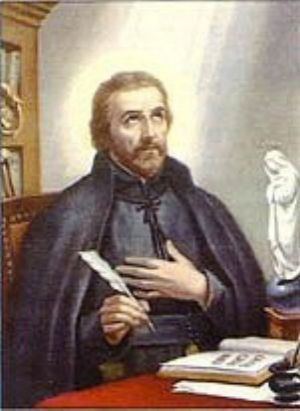
Canisius also exerted a strong influence on the Emperor Ferdinand I. The king's eldest son (later Maximilian II) appointed to the office of court preacher, Phauser, a married priest, who preached the Lutheran doctrine. Canisius warned Ferdinand I, verbally and in writing, and opposed Phauser in public disputations. Maximilian was obliged to dismiss Phauser and, on this account, the rest of his life he harboured a grudge against Canisius.
In 1547 he attended several sessions of the Council of Trent. Canisius was an influential teacher and preacher, especially through his "German Catechism", a book which defined the basic principles of Catholicism in the German language and made them more accessible to readers in German-speaking countries. He was offered the post of Bishop of Vienna in 1554, but declined in order to continue his traveling and teachings. He did, however, serve as administrator of the Diocese of Vienna for one year, until a new bishop was appointed for it.
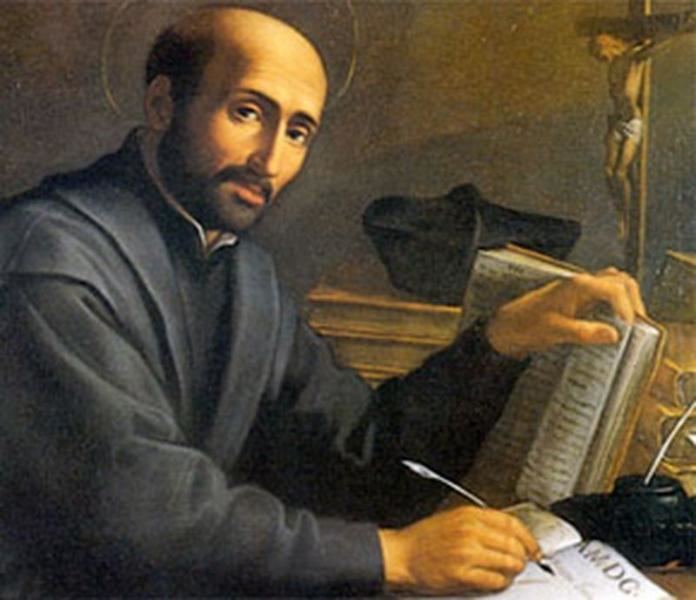
He moved to Germany, where he was one of the main Catholic theologians at the Colloquy of Worms in 1557, and later served as the main preacher in the Cathedral of Augsburg from 1559 to 1568, where he strongly witnessed to his faith on three or four occasions each week. Canisius was renowned as a popular preacher. In 1562 he founded what was to become the University of Innsbruck.
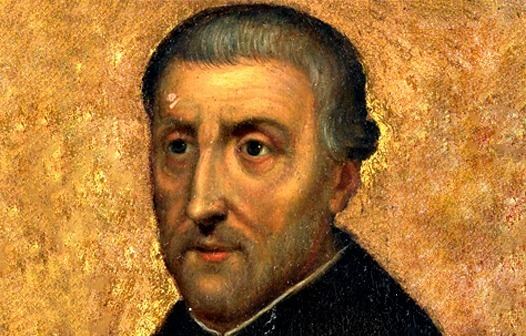
By the time he left Germany, the Society of Jesus in Germany had evolved from a small band of priests into a powerful tool of the Counter Reformation. Canisius spent the last twenty years of his life in Fribourg, where he founded the Jesuit Collège Saint-Michel, which trained generations of young men for careers and future university studies.
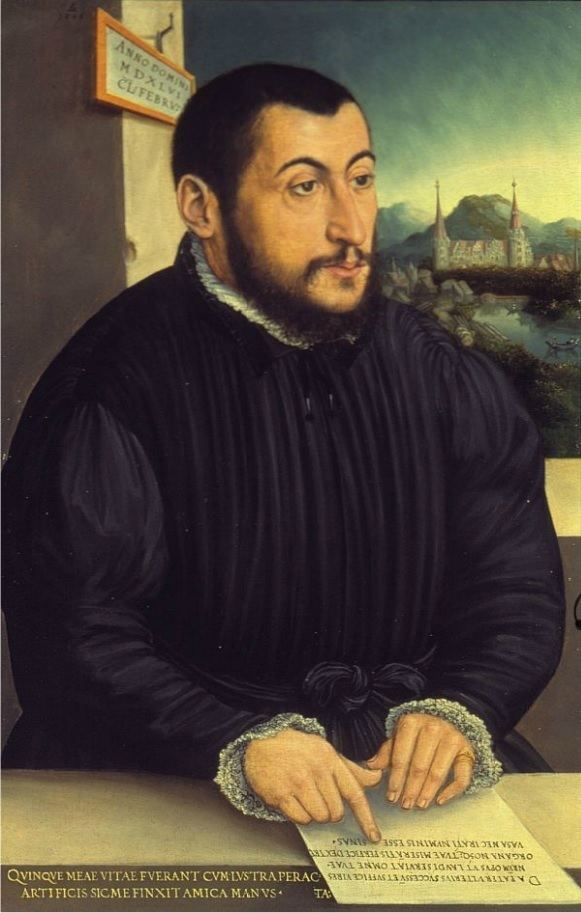
In 1591, at the age of 70, Canisius suffered a stroke which left him partially paralyzed, but he continued to preach and write with the aid of a secretary until his death in Fribourg.
He was initially buried at the Church of St Nicholas. His remains were later transferred to the church of the Jesuit College, which he had founded and where he had spent the last year of his life, and interred in front of the main altar of the church; the room he occupied during those last months is now a chapel open for the veneration of the faithful.
Pastoral strategy
Canisius lived during the height of the Protestant Reformation and dedicated much of his work to the clarification of the Catholic faith in light of the emergence of the new Protestant doctrines. His lasting contribution is his three catechisms, which he published in Latin and German, which became widespread and popular in Catholic regions. In his fight with German Protestantism, he requested much more flexibility from Rome, arguing:
If you treat them right, the Germans will give you everything. Many err in matters of faith, but without arrogance. They err the German way, mostly honest, a bit simple-minded, but very open for everything Lutheran. An honest explanation of the faith would be much more effective than a polemical attack against reformers.
He rejected attacks against John Calvin and Melanchton: With words like these, we don’t cure patients, we make them incurable.
Mariology of Canisius
Canisius taught that, while there are many roads leading to Jesus Christ, for him the veneration of the Blessed Virgin Mary is the best. His sermons and letters document a clear preoccupation with Marian veneration. Under the heading "prayer" he explains the Ave Maria (Hail Mary), as the basis for Catholic Marian piety. Less known are his Marian books, in which he published prayers and contemplative texts. He is credited with adding to the Hail Mary the sentence
Holy Mary, Mother of God, pray for us sinners. Eleven years later it was included in the Catechism of the Council of Trent of 1566.Canisius published an applied Mariology for preachers, in which Mary is described in tender and warm words. He actively promoted the sodalities of our Lady and the rosary associations. Theologically, Canisius defended Catholic Mariology, in his 1577 book, De Maria Virgine Incomparabili et Dei Genitrice Sacrosancta Libri Quinque.
The book was ordered by Pope Pius V to present a factual presentation of the Catholic Marian teachings in the Bible, the early Christians, the Church Fathers and contemporary theology. Canisius explains and documents Church teachings through the ages regarding the person and character of Mary, her virtues and youth. He traces historical documents about the perpetual virginity of Mary, and her freedom from sin. He explains the dogma of "Mother of God" with numerous quotations from the fathers after the Council of Ephesus. He shows that Church teaching has not changed. He answers the sola Scriptura arguments of Protestants by analyzing the biblical basis for mariology. Book five explains the Catholic view of the assumption as living faith for centuries, supported by most proment Church writers. In addition he justifies the cult of Mary within the Catholic Church.
From today's perspective, Canisius clearly erred in some of his sources, but, because of his factual analysis of original sources, it is considered as representing one of the best theological achievements in the 16th century.
Veneration
Canisius was beatified by Pope Pius IX in the year 1864, and later canonized and declared a Doctor of the Church on 21 May 1925 by Pope Pius XI. His feast day was included in the General Roman Calendar in 1926, for celebration on 27 April. In the liturgical reform of 1969, it was moved to 21 December, the anniversary of his death, the normal day for celebrating a saint's entry into heaven (although it is still kept by the Society of Jesus on 27 April).
Legacy
In recognition of Canisius' early work in the establishment of Jesuit education, there are multiple educational institutions named for him. Among them is the Canisius College for seminarians in Vienna, Austria, the first institution named for him, as well as Canisius College, a Jesuit secondary school in his hometown of Nijmegen and the alma mater of Peter Hans Kolvenbach, a recent Superior General of the Society of Jesus. Another Canisius College, a university, and Canisius High School, a secondary school, are located in Buffalo, New York. Furthermore, a Jesuit-run Canisius Kolleg can be found in Berlin, Germany. There are also two secondary schools named after Canisius, Kolese Kanisius (Collegium Canisianum or Canisius College), in Jakarta, Indonesia and Canisianum Roman Catholic HS in the Omusati Region of Namibia, Africa
In addition, there is a primary school: Basisschool Petrus Canisius in Puth in Limburg, Netherlands. In 1850 the Canisius Hospital was established on the corner of the Houtmarkt and the Pauwelstraat in Nijmegen. In 1974 it merged with Wilhelmina Hospital located at the Weg door Jonkerbos in Nijmegen, to become Canisius-Wilhemina Hospital.
The Apologetische Vereniging St. Petrus Canisius (St. Peter Canisius Association for Apologetics) was founded in the Netherlands in 1904 to defend the Roman Catholic Church against socialism and liberalism.
From the middle of the nineteenth century on German churchmen, including Michael Cardinal von Faulhaber (1869-1952), considered Canisius as a new "Apostle of Germany", a successor of Saint Boniface, for his importance for German Christianity.
Works
The longer version (with quotes from authority):
Vol. 1: Faith, Hope, Charity, the Precepts of the ChurchVol. 2: The SacramentsVol. 3: Christian Justification, good works, Cardinal Virtues, Gifts and Fruits of the Holy Ghost, Eight Beatitudes, Evangelical Counsels, etc.